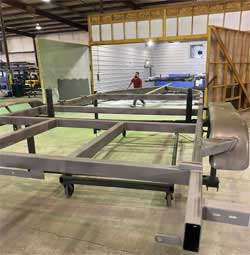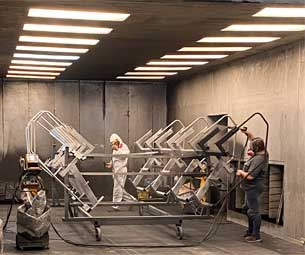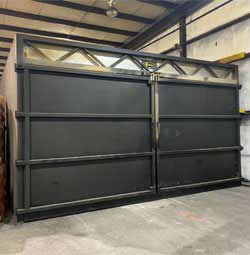 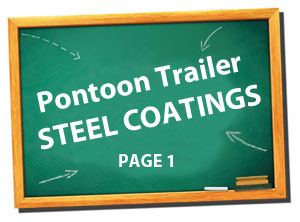 HOME | 1 | 2 | |
||||||||||
Steel Coating: Painting, Powder-Coating, and Galvanizing |
||||||||||
|
Few pontoon trailer
manufacturers provide a
warranty on the finish of
their trailers. This doesn’t
mean the trailer doesn’t
have a good paint job; it’s
just that the consumer can
ruin the finish even on the
best trailer. Travel down a
gravel road too fast and
you’ll chip almost any type
of coating. Take a painted
or even powder coated
trailer to salt water and
you’ll ruin the steel
coating. Haul a trailer for
an extended period on roads
treated with rock salt and
you’ll damage the finish. The coating on a pontoon trailer, assuming you have a good finish to begin with, is a maintenance issue. When a customer inquires if the wheel bearings are greased or the tires properly inflated the answer should be yes, but you will have to grease them later and you should check the pressure occasionally. The finish on pontoon trailers is a bit like grease in bearings or tire pressure. It requires some attention. How the finish stands up on a new trailer depends on the original coating. If it’s a good quality finish, it’s up to the trailer’s owner to keep it looking new. Like wheel bearings and tire pressure it’s a good idea to check the finish on a new trailer at the time you take delivery. You’ll be able to tell a good paint job from a poor one. If you start with a good quality finish, a little touch up now and then will keep it looking new for years. The best thing you can do for the finish of your new trailer is to apply a protective coat of automotive wax to the frame. Just like on your car, the paint protects the steel and the wax protects the paint. |
||||||||||
 |
||||||||||
 There are friction points on
pontoon trailers. Where the
bunk brackets are bolted to
the frame, where the winch
stand is bolted to the
tongue, where the tongue
jack is attached, etc. Lug
nuts will often chaff the
painted finish on the white
tire rims. Surfaces in
contact with each other will
wear away paint (or thin
galvanizing) and over time
you’ll see rust. Rusty
hardware is an ongoing
problem. Most trailer
manufacturers use cadmium
plated hardware. It’s not
stainless but in general
it’s not prone to rusting in
normal use (not salt water).
There seems to be no
solution for rusty hardware.
It is a problem on all
trailers.
There are friction points on
pontoon trailers. Where the
bunk brackets are bolted to
the frame, where the winch
stand is bolted to the
tongue, where the tongue
jack is attached, etc. Lug
nuts will often chaff the
painted finish on the white
tire rims. Surfaces in
contact with each other will
wear away paint (or thin
galvanizing) and over time
you’ll see rust. Rusty
hardware is an ongoing
problem. Most trailer
manufacturers use cadmium
plated hardware. It’s not
stainless but in general
it’s not prone to rusting in
normal use (not salt water).
There seems to be no
solution for rusty hardware.
It is a problem on all
trailers. Many pontoon trailers are black. Black is a “soft” color. That means that a generic can of black touch up paint can usually match most black trailer finishes. Touching up rust spots as you see them will keep your trailer looking new for years. Some pontoon trailers have custom colors with beautiful deep gloss finishes, but be prepared to keep a matching can of custom color touch up paint on hand. Below you can see numerous brands of trailers with rust. Some have state of the art powder-coat finishes and the coating on these brands were the best available, at the time they were new. Others are poorly painted and you’ll see that (if you look) on the day you take delivery on your new trailer. A trailer with a good strong modern powder coat finish is desirable but like wheel bearings or tires, the long term finish on a pontoon trailer is a maintenance issue. |
||||||||||
 |
||||||||||
| Shore Land’r and Trailmaster generally have excellent finishes, but you can see what happens if a good paint job is neglected. | ||||||||||
 |
||||||||||
| Scratches on this E Z Loader could be easily touched up. The rust on the Bear was probably caused by a tongue jack being moved. It would have been a simple touch up at the time but will now require sanding and priming. | ||||||||||
 |
||||||||||
|
Loose Chains "beat" the
paint off
The powder coat on this
trailer seems to have just
chipped off. this frame. |
||||||||||
 |
||||||||||
| Blemishes in steel (small rough spots) plague all trailer builders. Few manufacturers prep the steel. Many don’t even prime it. Ideally the individual cutting the steel parts would notice rough spots. Before welding, a quick check of the surface would allow the manufacturer to put rough steel on the bottom or inside of the frame. Before coating a few minutes with a grinding wheel or sandpaper would prevent this. But it’s a common problem on all steel trailers. Surface blemishes in steel affect both galvanizing and powder coating. Since most trailer manufacturers do not cover the finish of the trailer, the prevailing attitude of many manufacturers seems to be that it’s not their problem. When taking delivery of a new pontoon trailer, running your hand over the top of the frame will detect any rough spots beneath the steel. You may not be able to see them when new but rust spots will appear after a short time. | ||||||||||
 |
||||||||||
|
This trailer has scratches
on the top of the front
frame, probably from people
stepping on the trailer. A
simple touch up would
prevent rusting. |
||||||||||
Powder Coating |
||||||||||
| Most modern pontoon trailers are “powder coated”. EPA regulations and technology have made spray painting obsolete. Although some manufacturers who specialize in deluxe trailers may still “paint” their trailers. These are often very high quality (expensive) with several layers of acrylic. But most pontoon trailers are powder coated. The color is usually black for the simple reason that black is a “soft” color that is easily touched up should rust appear. | ||||||||||
| Modern Powder Coating | ||||||||||
|
Powder Coating is the modern method of sealing steel against corrosion. A piece of steel (trailer frame) is electrostatically charged and a dry powder is sprayed over the steel. The electric charge helps the powder stick to the steel. Then the frame is baked until the powder is melted. But there is a big difference between how trailer manufacturers do it. Large companies often have multi million dollar automated lines when the powder is applied at one end and the line slowly drags the frame through an oven at high temperatures. You’ll get a great strong finish on a Shore Land’r or E Z Loader. Other companies have systems that are good to poor. Cleaning the steel before the powder is applied and baking the powder into the steel are the most important steps. Bead blasting removes impurities and welding slag. Baking the powder at high temperatures melts the powder into the steel. I visited a manufacturer in Missouri that was powder coating in an old horse barn. Cleaning the frames consisted of rinsing them down with water. The oven wasn’t anything more than space heaters at the highest temperature. The owner described his system as cobbled together and it was obvious that the powder coating was marginal. It’s difficult to know what your getting on a new trailer. One key is to see if the manufacturer offers any quality story about the finish or an extended warranty. If they don’t, there probably isn’t a quality story. The images below are at BTM Trailers in Tennessee. BTM is part of a larger company that knows powder coating. The parent company makes steel window frames for sky scrapers. There must never be the chance that powder coating is anything except superior.
The most modern method of powder coating, introduced about 2019, is “textured” powder coat. It takes an expensive spray gun, uses more powder and must be baked at higher temperatures. But it provides an especially thick coating. Ordinary powder coating is usually 2-3 mils thick. Textured may be 8-11 mils. 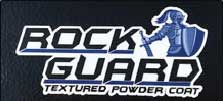 Different manufacturers call textured powder coat by different names. Crocodile Skin™, Rock Guard™, or Rust Guard™, etc. Instead of being a smooth finish, it’s textured or pebble grain. Similar to what you’d find in a good spray on truck bed liner. In doubt, run your hand over the top. Textured Powder Coat costs about 20% more than ordinary powder coating. Manufacturers usually advertise it as a benefit. |
||||||||||
 3 mil smooth finish - doesn't even cover the blemishes. |
 Thick, pebble grain finish. Run your hand over it. |
|||||||||
| HOME | 1 | 2 | | ||||||||||
| PONTOON TRAILERS 101 - FOR EVERYTHING YOU NEED TO KNOW ABOUT PONTOON BOAT TRAILERS | ||||||||||

